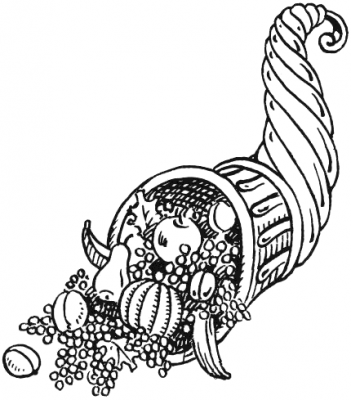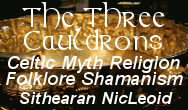Ariadne's Tribe: Minoan Spirituality for the Modern World
Walk the sacred labyrinth with Ariadne, the Minotaur, the Great Mothers, Dionysus, and the rest of the Minoan family of deities. Ariadne's Tribe is an independent spiritual tradition that brings the deities of the ancient Minoans alive in the modern world. We're a revivalist tradition, not a reconstructionist one. We rely heavily on shared gnosis and the practical realities of Paganism in the modern world. Ariadne's thread reaches across the millennia to connect us with the divine. Will you follow where it leads?
Find out all about Ariadne's Tribe at ariadnestribe.com. We're an inclusive, welcoming tradition, open to all who share our love for the Minoan deities and respect for our fellow human beings.
More Than Meets the Eye: The Minoan Goddess Amalthea
When I talk about Minoan spirituality, people tend to recognize the names Ariadne and Dionysus, and maybe Rhea and Minos as well.
But there's one that often leaves them shaking their heads: Amalthea. I actually had someone ask me one day if Amalthea was one of the characters from Game of Thrones. Um, no. LOL
Amalthea is a Minoan goddess who, like Ariadne and the others, was absorbed into later Greek myth as something less than divine (FYI the Minoans weren't Greek). But I promise you, she was originally a full-fledged goddess and not just a goat-herding foster mother of Zeus.
Zeus is a Greek god, not a Minoan one. Like the Romans, the Greeks enjoyed equating foreign deities with their own, both as a way to understand other pantheons and as a handy method for taking over those cultures and absorbing them. So when the Greeks say that Amalthea was the foster mother of "Cretan Zeus," they're talking about Dionysus, the Minoan god who is born in his mother Rhea's cave at the Winter Solstice. And Amalthea plays a role in that story.
Amalthea is the sister-twin of the Minoan Mother Goddess Rhea. When Dionysus is born, Rhea can't stay with him all the time; she has work to do. So she leaves him with Amalthea, who nurses him and takes care of him.
Amalthea is a goat-goddess, one of the Minoan Horned Ones who may date back to Neolithic times on Crete. So obviously, she feeds Dionysus on goat's milk (as well as honey, which she gets from the Melissae, the Minoan bee-goddesses who protect and guard the spirits of the dead in the Underworld). Like Rhea, Amalthea is associated with the sacred mountains and caves on Crete, particularly Mount Ida.
That cornucopia also comes from Amalthea. The story goes that the infant Dionysus was playing a bit too roughly with Amalthea in her goat form when he accidentally broke off one of her horns, which became the cornucopia.
I have a little trouble believing that this is the original story. To me, the cornucopia - also known to Wiccans as the Amalthean Horn - is another version of the Great Mother's bottomless pithos from which all things flow.
The original version of Pandora is Rhea Pandora, the All-Giver, whose giant vase is the Source of All and not a box full of bad things redeemed only by hope. Since Rhea is Amalthea's sister-twin, it only makes sense that Amalthea should have her own personal version of that vase, whose analogue we see in so many later mythologies: the Cauldron of Cerridwen, the Holy Grail.
The Greeks borrowed Amalthea's story into their mythos, though they demoted her to a nymph in much the same way that they demoted Minos and Ariadne to mortal humans.
In the Greek version, Zeus' aegis - his thunder-shield - is made from Amalthea's hide. This suggests to me that there was a Minoan original version of this, especially since the Kouretes danced outside the cave where the infant Dionysus lay, banging their spears on their shields to keep rhythm for their dance. Since the aegis is associated with thunder, that suggests another thread connecting both Amalthea and Rhea with Posidaeja, the Minoan sea-goddess.
There are a lot of tangled threads here, a lot of connections through time and space. But to me, one thing remains constant: the overwhelming generosity of Amalthea, whose cornucopia provides an endless bounty for those who honor her.
Comments
-
 Thursday, 30 March 2017
Thursday, 30 March 2017I haven't heard of Liny Srinivasan before, but I see that he has a page on academia.edu where he has posted some of his papers, so I'll have a look through them. I'm not familiar with that particular work by Cyrus Gordon (Eblatica). He had some very unorthodox views, including the idea that the Greeks were actually a Semitic people closely related to the Hebrews (which DNA testing now tells us is wrong). He wrote a lot about Ugarit and related areas. I believe it's in his book Forgotten Scripts that he claims to have translated Linear A. There are quite a few people who claim to have translated Linear A, but none of the translations hold water. We simply don't have enough Linear A text to make a definitive translation. I'm still holding out hope that we find a large cache of Linear A tablets somewhere that will increase our data to the point that standard decipherment techniques can be used, the way Ventris and Chadwick figured out Linear B.
-
Please login first in order for you to submit comments





















I'm slowly making my way through "Crete to Egypt: Missing Links of the Rig Veda" by Dr. Liny Srinivasan. The author's premise is that the titles of the Rig Veda gods are actually place names for middle eastern kings and warlords. One of the books the author references is Eblatica by Cyrus H. Gordon in which he is alleged to have translated linear A script. I don't have access to any of these three volumes. Have you heard of Gordon's work before or of Srinivasan's?